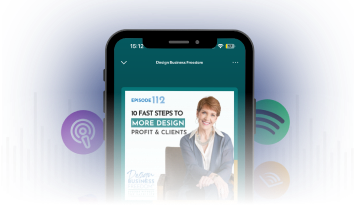When Bad Business Habits Happen to Good Designers
Every interior designer wants to run a successful business, but even the best of us can fall into bad habits that hinder our growth and profitability. These habits can creep in unnoticed, but they can have a significant impact on your business if not addressed. Let’s take a closer look at some common bad business habits that might be holding you back and explore strategies for overcoming bad design business habits.
1. Sample Hoarding
Are you guilty of holding onto samples long after their usefulness has expired? While it might seem harmless, keeping outdated or unused samples can clutter your workspace and lead to disorganization. Samples don’t age like fine wine—they get discontinued and take up valuable space.
Make it a habit to regularly return or dispose of samples you no longer need, or better yet, hire an intern to keep your sample library in check. Overcoming bad design business habits like sample hoarding can lead to a more organized and efficient workspace.
2. The Lazy Loop in Sourcing
If you find yourself returning to the same vendors and resources for every project, you might be stuck in what I call the “lazy loop.” This habit can make your designs start to look alike and limit your creativity.
Challenge yourself to explore new resources and set aside time each month to discover new manufacturers and products. Keeping your designs fresh and unique will help you stand out in a competitive market. Breaking free from the lazy loop is a key step in overcoming bad design business habits.
3. Procrastinating on Billing
Billing should be a priority, not an afterthought. If you’re dreading invoicing and pushing it to the end of the week, it’s time to change your approach. Make invoicing the first task of the week to ensure it gets done promptly.
Additionally, if you’re relying on hourly billing, consider shifting to flat fees to avoid the hassle of chasing payments and to better reflect the value of your work. Overcoming bad design business habits like procrastinating on billing can improve your cash flow and reduce stress.

4. Poor Client Communication
Waiting for your client to ask for updates is a recipe for frustration. Clients can feel neglected if they’re not kept in the loop, even when there isn’t much to report. Regular updates, even if brief, can reassure your clients and strengthen your relationship.
Set a schedule for weekly or bi-weekly updates and stick to it, ensuring your clients always feel valued and informed. Improving client communication is crucial for overcoming bad design business habits that can damage client relationships.
5. Inconsistent Marketing
Marketing only when you have the time or when you’re in the mood is a common but dangerous habit. Consistency is key to building a strong brand presence. Relying solely on word-of-mouth isn’t enough, especially during uncertain economic times.
Develop a consistent marketing strategy that includes regular social media posts, networking, and other outreach efforts to keep your pipeline full. Overcoming bad design business habits like inconsistent marketing will help ensure steady business growth.
6. Avoiding Testimonials
Don’t be shy about asking for testimonials. Many designers assume that if clients were truly happy, they would offer a testimonial without being asked. The truth is, clients are often busy and need a gentle nudge.
Reach out to them during a high point in the project and make it easy by offering to draft the testimonial for them. Testimonials are powerful tools that can tip the scales in your favor when potential clients are deciding whether to hire you.
7. Skimping on Photography
High-quality images of your work are one of your most important marketing assets. Don’t cut corners by using a real estate photographer or trying to take the photos yourself. Invest in a professional interior design photographer who can capture your work in the best light.
Additionally, consider hiring a stylist to ensure the space looks its absolute best during the shoot. Quality images can attract affluent, ideal clients and elevate your brand.
8. Neglecting Team Building
Are you only hiring part-time or fractional team members? While this might seem like a cost-saving measure, it can actually limit your growth. At some point, your business may require full-time team members to help you scale effectively.
Consider the long-term benefits of investing in a committed team that can fully support your vision and business goals.And this includes long term outsource providers as well.
Key Takeaways
Overcoming bad design business habits can sneak up on even the most talented designers, but with awareness and proactive changes, you can reclaim time, energy, and profit.
By addressing these habits head-on—whether it’s updating your sourcing methods, improving client communication, or investing in high-quality photography—you can create a more efficient, profitable, and fulfilling design business. Remember, the journey to success begins with overcoming bad design business habits that may be holding you back.If you’re ready to increase your interior design practice profits, work exclusively with ideal clients, and enjoy the time and resources for your extraordinary life, explore your coaching options. We’ve got your back in the business of interior design.





